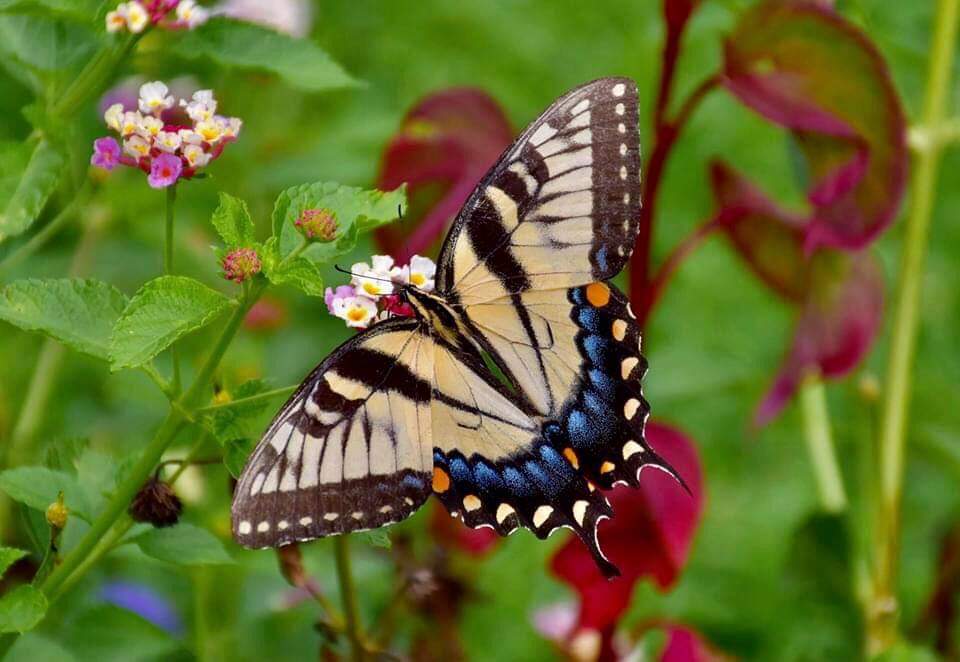Flitting elegantly from flower to flower, butterflies of all sorts grace the Colonial Garden in spring. They provide a beautiful show of color for those visiting the gardens and are quite the inspiration for artists of all ages. Their flights from plant to plant provide a quiet but joyful pastime for those seeking to relax and enjoy the more tranquil moments of nature.
In addition to their beauty, butterflies provide an important service to the lifecycle of many plants. They are beneficial insects and are important to the pollination of many plants. When they visit a flower, they are looking to drink nectar. Since butterflies lack chewing mouthparts they instead sip the nectar, and in some cases fruit juices, through a proboscis. The proboscis acts like a straw and when not in use is curled under the head of the butterfly. As they perch on the flower and position themselves to drink, their spindly legs and other parts of their bodies collect pollen on their scales. This pollen is then carried to another flower when the butterfly moves onto its next meal. The pollen collected may fertilize the plant the butterfly visits, thus allowing the plant to reproduce and continue its lifecycle.

Bees, on the other hand, tend to dive into flowers rather than perch, thus collecting pollen all over their bodies. They can fit into tighter spaces than butterflies can and the hair on the bees’ bodies trap more pollen than the scales found on the body of a butterfly, making them much more efficient pollinators since they can carry more pollen from plant to plant. However, butterflies can travel further than bees, thus spreading pollen in a larger area, and they can see more colors than bees, such as red, allowing them a greater range of plants to find and feed from. While not as efficient at pollinating as bees, butterflies are important pollinators for these reasons and more.
All butterflies follow the same life cycle of egg, larva (caterpillar), pupa (chrysalis), and adult. The egg is incredibly tiny, the size of the head of a needle, and is often green to blend in with the plant it is laid on. A female will lay hundreds of eggs in the hopes that some will survive to hatch. The caterpillar stage comes next; the job of a caterpillar is to eat, and they do it remarkably well. They eat and grow until they have enough energy stored for the next stage, the chrysalis. The job of the chrysalis is to disguise and protect the caterpillar while it goes through its metamorphosis into a butterfly. When this stage is complete, an adult butterfly emerges. The adult will now begin its search for a mate to reproduce with, thus continuing the cycle.





The Colonial Garden sees many types of butterflies, the most common being the Monarch Butterfly, the Zebra Swallowtail, the Black Swallowtail, and the Eastern Tiger Swallowtail. All of these visit the garden, but depending on the species, they are only interested in specific host plants. Butterflies rely on host plants for their life cycle, meaning certain species will only lay eggs on certain plants that are edible to the caterpillar that hatches. Monarchs, for instance will use Swamp Milkweed (Asclepias incarnata), and many other plants in the genus of Asclepias for their hosts. This is beneficial to the Monarch because Milkweed is toxic and having evolved to tolerate the toxin, they are able to store it in their bodies. This evolution makes them poisonous to many predators.

Likewise, Zebra Swallowtails use many types of pawpaws (Asimina) as their host plant. The chemicals found in this genus of plant are also stored in their bodies and may offer some protection from birds. The Eastern Tiger Swallowtail uses many plants in the Magnoliaceae and Rosaceae families for hosts, with the caterpillar using mimicry to protect itself; first appearing similar to bird droppings, then developing eyespots to appear similar to a snake. The Black Swallowtail chooses to lay its eggs on many plants on the Apiaceae family, like parsley and dill, and proves to be a nuisance to many gardeners for this reason. Rather than killing them, we recommend moving the caterpillars to a larger, hardier plant that can handle the leaves being eaten, like parsnips. Most of the caterpillars will be eaten by birds and other critters after a few days from hatching, but if you want the benefits and beauty of the adult butterfly you have to work with the nuisance of the caterpillar.

There are of course many more butterflies and pollinators that visit the Colonial Garden than those listed here. Next time you are taking a walk, either in the Historic Area or a park, see how many different kinds you can identify and what plants they are interested in! For those wishing to attract butterflies to their own home gardens this is an important observation to make. Your local botanical garden or extension service will also be able to give you advice on what to do to attract beneficial insects in your state and zone. Happy Gardening!
Megan Cantwell is a second level Apprentice Gardener in Historic Skills and Trades. She enjoys gardening both in the Colonial Garden and at her own garden at home. Deer, rabbits, and squirrels are some of her favorite animals, however, they are also her mortal enemies. She enjoys reading fantasy and sci-fi novels, cooking, and video games.
